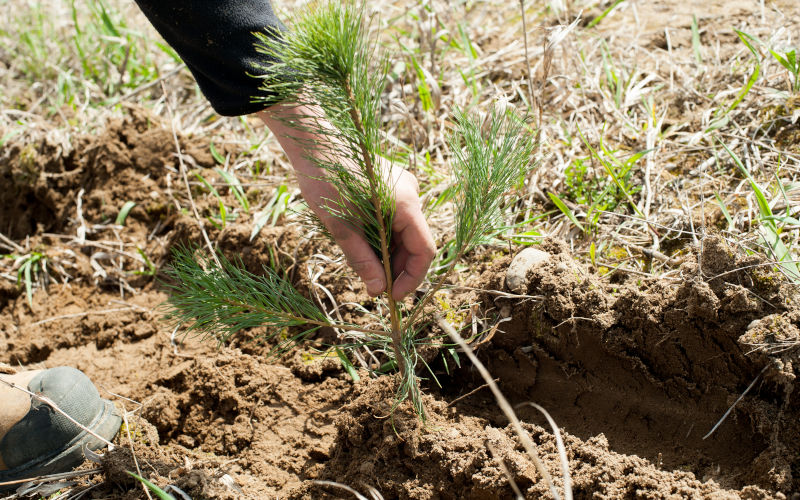Realizing Expectations from Planting Trees on Private Land in Ontario, Canada
DOI:
https://doi.org/10.3097/LO.202078Keywords:
tree planting, afforestation, wildlife, motivationAbstract
This study explores the motivations behind participation in tree planting programs by private landowners in Ontario, Canada, as well as perceptions as to whether benefits were realized up to ten years after trees were planted. Forests Ontario, which has offered tree planting support programs in this province since 2007, provides up to 90% of the cost of seedlings for tree planting projects at least one hectare (ha) in size. This online survey of 570 former participants in tree planting programs indicated that a desire to create a habitat for wildlife (77.6%) was the most common motivation for taking part in a tree planting program. Concern with restoring native forest cover was also a reason for most participants (71.4%), as well as with improving soil, air and water quality (54.8%), and addressing climate change (54.3%). The most common benefit of planting trees was an increase in well-being and enjoyment of their property (67% of respondents). Overall, 27% of respondents with a desire to increase wildlife habitat, and 20% of those wishing to improve their local environment reported an improvement after tree planting. Reported improvements in the local environment and wildlife increased with time since tree planting, whereas enhanced well-being and enjoyment of the property were evident among participants even with newly planted trees.
References
ArborVitae Environmental Services Ltd., Woodrising Consulting Inc., and P. Duinker 1999. Estimating the carbon sequestration benefits of afforestation in Ontario, Quebec, and the Atlantic provinces. National Climate Change Process Joint Forest Sector Table/Sinks Table Afforestation Studies #2 and #3 Ottawa, ON, 91 pp.
Borczon, E.L. 1982. Evergreen Challenge: The Agreement Forest Story. Ontario Ministry of Natural Resources. 60 p.
Butler, B.J., Hewes, J.H., Dickinson, B.J., Andrejczyk, K., Butler, S.M., & Markowski-Lindsay, M. 2016. Family forest ownerships of the United States, 2013: Findings from the USDA forest service’s national woodland owner survey. Journal of Forestry 114, 638-647. DOI:10.5849/jof.15-099 DOI: https://doi.org/10.5849/jof.15-099
Butler, B.J. 2008. Family forest owners of the United States, 2006. Gen. Tech. Rep. NRS-27. Newtown Square, PA: US Department of Agriculture, Forest Service, Northern Research Station. 72 p. DOI:10.2737/NRS-GTR-27 DOI: https://doi.org/10.2737/NRS-GTR-27
Butler, B.J., Leatherberry, E.C., Best, C., Kilgore, M.A., Sampson, R.N., & Larson, K. 2004. America’s family forest owners. Journal of Forestry 102, 4-14. DOI:10.1093/jof/102.7.4
Butt, S., Ramprasad, P., Fenech, A. 2005. Changes in the landscape of southern Ontario Canada since 1750. Integrated Mapping Assessment 83-92. https://www.islandscholar.ca/islandora/object/ir%3A4185/datastream/PDF/view (Date: 03.04.2019).
Carmichael, C., & McDonough, M. 2018. The trouble with trees? social and political dynamics of street tree-planting efforts in Detroit, Michigan, USA. Urban Forestry & Urban Greening 31, 221-229. DOI:10.1016/j.ufug.2018.03.009 DOI: https://doi.org/10.1016/j.ufug.2018.03.009
Cherry, M. 2001. Options for allocation of tree planting stock for afforestation in ontario with anticipated climate change. Forest Research Information Paper No 148. Report prepared for the Ontario Ministry of Natural Resources. ISBN 0-7794-2260-0
Conway, T.M. 2016. Tending their urban forest: Residents’ motivations for tree planting and removal. Urban Forestry and Urban Greening 17, 23-32. DOI:10.1016/j.ufug.2016.03.008 DOI: https://doi.org/10.1016/j.ufug.2016.03.008
Cook, C., Heath, F., & Thompson, R. L. 2000. A meta-analysis of response rates in Web- or internet-based surveys. Educational and Psychological Measurement 60, 821-836. DOI:10.1177/00131640021970934 DOI: https://doi.org/10.1177/00131640021970934
Côté, M., Gilbert, D., & Nadeau, S. 2015. Characterizing the profiles, motivations and behaviour of Quebec’s forest owners. Forest Policy and Economics 59, 83-90. DOI:10.1016/j.forpol.2015.06.004 DOI: https://doi.org/10.1016/j.forpol.2015.06.004
Elliott, KA. 1998. The forests of southern Ontario. The Forestry Chronicle 74(6):850-854. https://pubs.cif-ifc.org/doi/pdf/10.5558/tfc74850-6( Date: 03.04.2019). DOI: https://doi.org/10.5558/tfc74850-6
Forests Ontario. 2017. Forests Ontario Commends the Ontario Governmentfor Increasing Funding for Tree Planting Program. https://www.newswire.ca/news-releases/forests-ontario-commends-the-ontario-government-for-increasing-funding-for-tree-planting-program-642254903.html (Date: 05.12.2018).
Government of Ontario. 2007. Go Green: Ontario’s Action Plan on Climate Change. http://www.climateontario.ca/doc/workshop/2011LakeSimcoe/Ontarios%20Go%20Green%20Action%20Plan%20on%20Climate%20Change.pdf (Date: 05.12.2018).
Hartig, T., Evans, G.W., Jamner, L.D., Davis, D.S., & Gärling, T. 2003. Tracking restoration in natural and urban field settings. Journal of Environmental Psychology 23, 109-123. DOI:10.1016/S0272-4944(02)00109-3 DOI: https://doi.org/10.1016/S0272-4944(02)00109-3
Keniger, L.E., Gaston, K.J., Irvine, K.N., & Fuller, R.A. 2013. What are the benefits of interacting with nature? International journal of environmental research and public health 10, 913-935. DOI:10.3390/ijerph10030913 DOI: https://doi.org/10.3390/ijerph10030913
MacDonald, H., McKenney, D.W., Pedlar, J.H., Hope, E.S., McLaven, K., & Perry, S. (2018). Adoption influences in Ontario’s 50 million tree program. Forestry Chronicle 94(3), 221-229. DOI:10.5558/tfc2018-035
Messer, B.L., & Dillman, D.A. 2011. Surveying the general public over the internet using address- based sampling and mail contact procedures. Public opinion quarterly 75, 429-457. DOI:10.1093/poq/nfr021 DOI: https://doi.org/10.1093/poq/nfr021
Ontario Ministry of Natural Resources 2001. Critical review of historical and current tree planting programs on private lands in Ontario, project done in partial completion of project CC-109.
Ross-Davis, A.L., Broussard, S.R., Jacobs, D.F., Davis, A.S. 2005. Afforestation motivations of private landowners: an examination of hardwood tree plantings in Indiana. Northern Journal of Applied Forestry 22(3):149-153. DOI:10.1093/njaf/22.3.149 DOI: https://doi.org/10.1093/njaf/22.3.149
Ruseva, T.B., Evans, T.P., Fischer, B.C. 2015. Can incentives make a difference? Assessing the effects of policy tools for encouraging tree- planting on private lands. Journal Environmental Management 155, 162-170. DOI:10.1016/j.jenvman.2015.03.026 DOI: https://doi.org/10.1016/j.jenvman.2015.03.026
Van den Berg, A.E., Koole, SL., & Van der Wulp, N.Y. 2003. Environmental preference and restoration:(How) are they related? Journal of Environmental Psychology 23, 135-146. DOI:10.1016/S0272-4944(02)00111-1 DOI: https://doi.org/10.1016/S0272-4944(02)00111-1

Downloads
Published
How to Cite
Issue
Section
License
Copyright (c) 2020 Heather MacDonald, Daniel McKenney, Kerry McLaven, Suzanne Perry

This work is licensed under a Creative Commons Attribution 4.0 International License.










